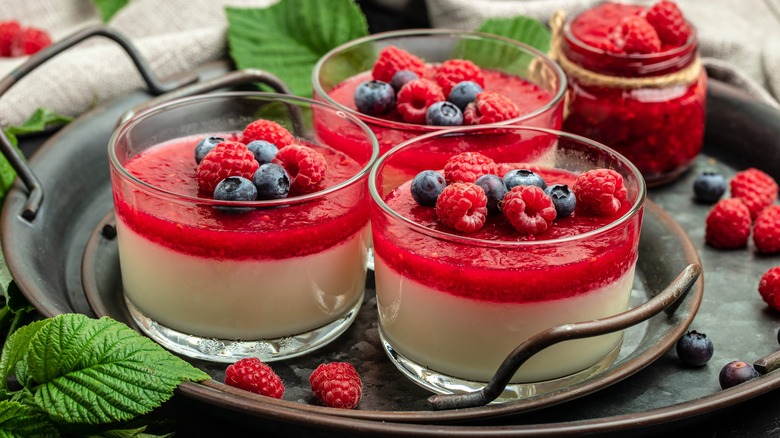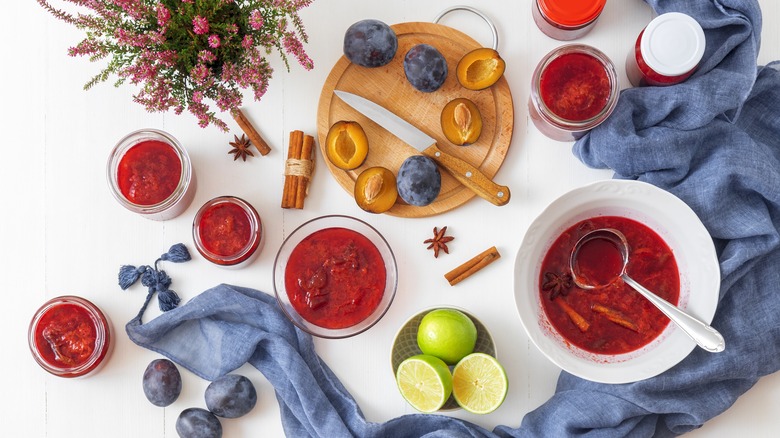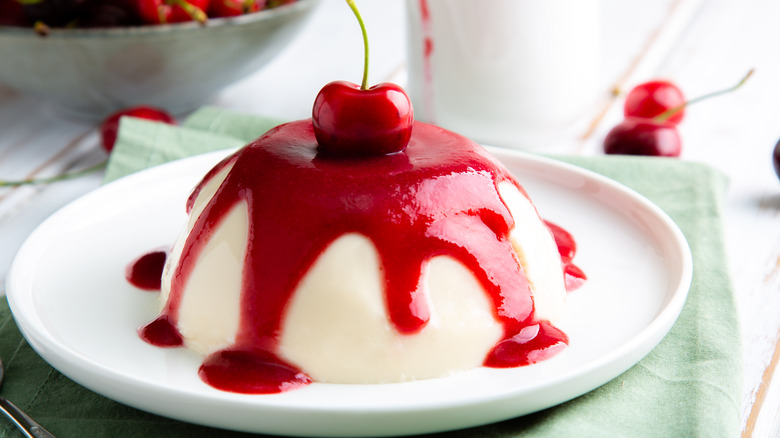Compote Vs Coulis: Is There A Difference Between The Dessert Sauces?
Picture this: You're out to dinner at a relatively fancy restaurant and enjoyed a lovely meal with attentive service and thoughtful conversation. The server clears the plates and hands you the dessert menu, where you're confronted with the terms "coulis" and "compote." Unsure, you glance around at your dining partners with unease, who also seem to be unfamiliar with the terms. Here, you're faced with the decision to discretely try to look these words up on your phone or abashedly call over a server in hopes of an explanation.
Thankfully there's nothing to be ashamed of. You aren't alone in your unawareness of these unfamiliar terms that don't usually make their way into the everyday lexicon. They may sound similar in context, but there is a difference between these two dessert sauces.
Think of coulis and compotes as cousins rather than siblings. They are both sauces that are frequently used in dessert preparations, but they differ in texture and flavors. While they are usually sweet items, both compotes and coulis can lean savory as well, depending on the ingredients. You may have even seen some savory applications before, like scallops bathed in a red pepper and carrot coulis, or a spiced cherry compote adorning a seared duck breast.
Compotes have more body and a robust flavor
In simple terms, a compote is a condiment comprised of fruit that's been stewed on low heat for a long period of time until soft and broken down, and it usually includes spices or other extracts to give it more depth of flavor. Compotes tend to be served warm or at room temperature and have been eaten since late medieval days beginning in Europe.
A compote is usually made with fresh fruit but can also be made from dried fruit that's been rehydrated. Compotes are cooked down with sugar and liquid – commonly water and, sometimes, added wine or an alcohol whose flavor will complement the overall taste of the compote. Making a compote is, in fact, so easy that it may shock you to know that a simple berry compote can be made in a french press in seconds. A compote will last about two weeks in the refrigerator, and even longer if you freeze it in small batches; just let it defrost overnight in the refrigerator before using for the best texture.
A simple strawberry compote is an ideal way to bring texture and sauciness to a summertime dessert, and in the fall and winter, take advantage of the best types of apples to use for an autumn compote. Not just for desserts, a compote is an ideal topping to add sweetness to hearty dishes, like oatmeal, and you can even give traditional cranberry sauce an upgrade at Thanksgiving by making this cranberry-Riesling compote.
Coulis is compote's silky smooth cousin
Initially, coulis was a French word used for the extremely flavorful fat and drippings leftover from cooked meat, which later evolved into meaning pureed and strained soups and, finally, grew to mean what we know today as a sauce, usually made from fruit, but not always; sometimes, vegetables are also used in place of fruit. Similar to a compote, a dessert coulis also has a base of fruits cooked down in a sweet liquid. Unlike a compote, however, the mixture is then pureed to a smooth consistency and strained to eliminate any solids or graininess. Since it's passed through a fine strainer, a coulis generally has a silky, pleasant mouthfeel as compared to a chunky compote.
A coulis is a versatile sweet sauce that you should know how to make as it is relatively easy to cook but has a big impact on the food it's served with. A berry coulis is a classic pairing for pancakes or French toast and is an especially common topping for cheesecakes and other creamy desserts like panna cotta, as the acid from the fruit helps to cut through the richness of the dairy. They don't all have to be cloyingly sweet nor made entirely out of fruit puree, like in this peanut butter cups with Cabernet coulis recipe. Both a coulis and a compote are great ways to use up fruits that are a bit past their peak freshness.


